❚ The products mentioned in this article are selected or reviewed independently by our journalists. When you buy through links on our site we may earn an affiliate commission, but this never influences our opinion.
It might be a basic thing, but being able to pump up your bike’s tyres is an essential skill for any cyclist.
A lot of you will already know how to do this, but for those who don’t, the different valve types, pumps and, more importantly, what pressure to pump your tyre can be a bit overwhelming. Let us guide you through the process.
Pneumatic tyres were invented to get over the bone-jarring ‘ride-quality’ of solid wheels.
The air inside acts as a spring, providing suspension for you and allowing the tyre to conform to the terrain providing better traction and grip.
Pumping up your tyres is a quick job that can easily improve your enjoyment while riding. Running the wrong tyre pressure will negatively affect the way that your bike rides and can also make your bike more prone to punctures.
If you’ve never repaired a puncture before, you might not have considered how your tyres hold air inside.
The vast majority of bikes will use an inner tube. This is a doughnut shaped airtight tube that sits inside the tyre, with a valve for pumping it up that you see on the outside.
The tyre, when inflated by the tube, is what grips the ground and provides protection from punctures.
You may have heard of tubeless tyres, which forgo a tube and use a special rim and tyre to seal air without the need for a tube. These usually require tubeless sealant inside, which is a liquid that plugs any points where air is escaping.
Tubeless tyres are more commonly found in mountain biking, but the technology is migrating to road bikes.
The tubeless sealant also plugs punctures, and no tube means a much lower risk of pinch flats – that’s when your inner tube is pinched by the rim, causing a puncture. Tubeless tyres can, therefore, be run at lower pressures than those with an inner tube setup, for improved comfort, speed and traction.
Tubeless tyres can, therefore, be run at lower pressures than those with an inner tube setup, for improved comfort, speed and traction.
At the very high end, you also get tubular tyres. This is essentially a tyre with the tube sewn into it, but they are rarely seen or used outside of professional racing.
Inflating your tyres to the correct pressure is an essential part of bike maintenance.Oli Woodman / Immediate Media
Running your tyres at either too high or too low a pressure can be potentially dangerous, as well as negatively impact the handling of your bike.
We’ll discuss later what the correct pressure is, but for the moment let’s look at possible problems.
An under-inflated tyre will rob your efficiency and leave you susceptible to annoying punctures.Oli Woodman / Immediate Media
If you run your tyres at too low a pressure, the tyre can wear prematurely. Excessive flexing in the sidewall can lead to the casing cracking and the tyre becoming fragile. This could eventually lead to a blowout.
This could eventually lead to a blowout.
Excessively low pressures also increase your susceptibility to punctures and may even result in your tyres literally rolling off the rim if you corner at speed (the pressure inside is what holds your tyre on the rim).
Damage can also be caused if the tyre deflects all the way down to the rim. This can result in dents or cracking, potentially compromising your wheel and resulting in an expensive replacement.
Conversely, running too high a pressure could result in your tyre blowing off the rim with explosive consequences. That pressure can also squeeze the wheel because if it’s too high the compressive force on the wheel can be too high.
In terms of handling, a low pressure can result in compromised handling with the tyre squirming under load. Your bike will feel difficult to control, slow and sluggish.
On the other hand, too high pressure can result in reduced grip and a harsh ride, leading to fatigue and in turn impacting handling.
There are two likely reasons why your tyre is flat. Either you have a puncture or your tyre has just deflated over time.
If you have a puncture, we’ve put together a comprehensive guide on how to fix a puncture.
Glueless patches are great for a quick fix, while a more traditional kit is a versatile option when you have a bit more time.
All tyre systems will leak air slowly because tubes aren’t completely airtight. For example, standard butyl tubes hold air fairly well compared to lightweight latex tubes, which leak comparatively quicker. Even tubeless setups will slowly leak air.
Old tubes will leak more air than new ones, so if yours haven’t been replaced in a while they may be worth looking at. Less likely, but also a possibility (especially on older tubes), is that the valve is no longer sealing properly.
The best way to check what’s going on is to try pumping up the tyre. If it holds air then there’s likely nothing more you need to do.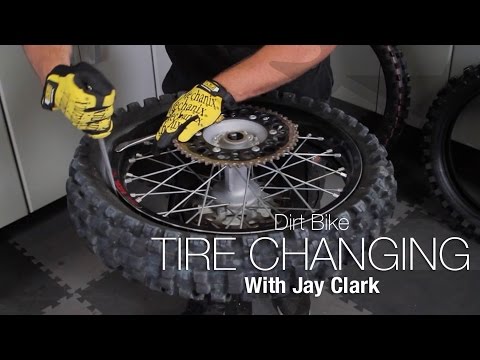 If it doesn’t, then you likely have a puncture.
If it doesn’t, then you likely have a puncture.
If it leaks air slowly overnight, either you have a slow puncture or simply an old tube that needs replacing.
The first thing you’ll need to know before pumping up your tyre is what valve type is fitted.
The valve is the key part that keeps air in the tyre, but also lets you inflate (or deflate) the tyre.
The Schrader valve is also used for car tyres.Oli Woodman / Immediate Media
Schrader valves are more common on lower-end bikes and, in the past, mountain bikes. The same valves are used on car tyres.
The valve assembly is a hollow tube with a sprung valve that closes automatically and screws into the external body. A pin extends up from the valve and is usually flush with the end of the outer tube. This pin can be depressed to let air out.
The dust cap on Schrader valves is an important part of the design that can help fully seal the valve if it is not completely air-tight. It essentially provides a secondary ‘backup’ seal.
It essentially provides a secondary ‘backup’ seal.
The sprung design of the valve is a little susceptible to contamination from dirt or grit so it’s important to protect it too.
Presta valves such as this one are longer and narrower than the Schrader type valve.Oli Woodman / Immediate Media
You will only find Presta valves on bicycles.
They originated on road bikes where the narrower valve (6mm vs 8mm for a Schrader) meant a smaller valve hole (typically the weakest part of a rim) on narrow road wheels.
Nowadays they are seen on both mountain bikes and road bikes. Rather than use a spring, the valve is secured with a nut that holds it closed, though the valve itself is sealed ‘automatically’ when pressure inside the tyre pushes it shut.
With a Schrader valve, you can simply press the pin to release air, but with a Presta valve you first have to unscrew the little locknut. Don’t worry about the nut coming off the end of the valve body because the threads are peened to stop that happening.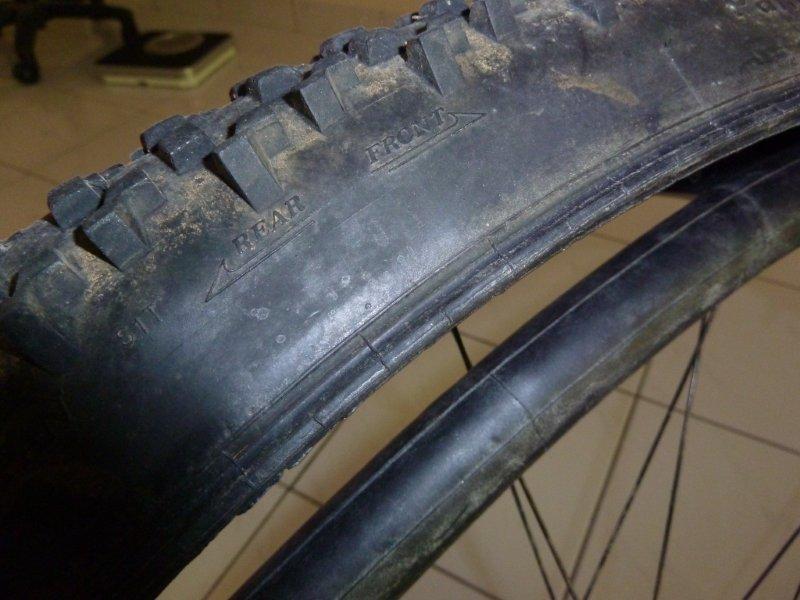
There seems to be a myth that Presta valves deal with high pressures better – this probably isn’t true considering there are Schrader valves that can withstand many hundreds of psi (way more than you’ll ever need in your tyre).
Presta valves are definitely a little more delicate than Schrader valves, though. It’s quite easy to knock the threaded internal valve body and bend or break it, so a bit more care needs to be taken. However, valve cores are easily replaceable with standard tools.
In comparison, on Schrader valves, this requires a proprietary tool.
Presta valves may come with a lockring that secures the valve body against the rim. This can make them a little easier to inflate. The dust cap is not essential to seal it, but helps keep the valve clean.
The only other type of valve you may come across is a Dunlop (also known as Woods) valve. This has a similar base diameter to a Schrader valve, but can be inflated with the same pump fitting as a Presta valve.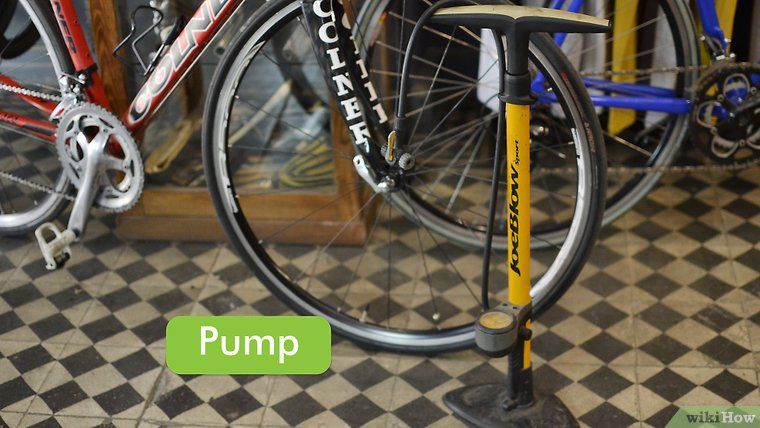
These are very popular on town/upright bikes in Europe and elsewhere in the world, but you’re very unlikely to come across one in the UK or in the US.
A tubeless valve can be difficult to distinguish from a regular Presta valve.Oli Woodman / Immediate Media
Valves for tubeless setups are attached directly to the rim, rather than being part of an inner tube.
More often than not, they are Presta-type, but Schrader ones do exist.
Oli Woodman / Immediate Media
If you’ve got a Schrader type valve, such as the one shown above, then the first thing you need to do is remove the dust cap (if there is one in place).
Oli Woodman / Immediate Media
Simply unscrew the cap anticlockwise to reveal the valve.
Oli Woodman / Immediate Media
Now attach the head of your pump.
Oli Woodman / Immediate Media
Inflate the tyre to a value between the minimum and maximum stated on the tyre sidewall and remove the pump.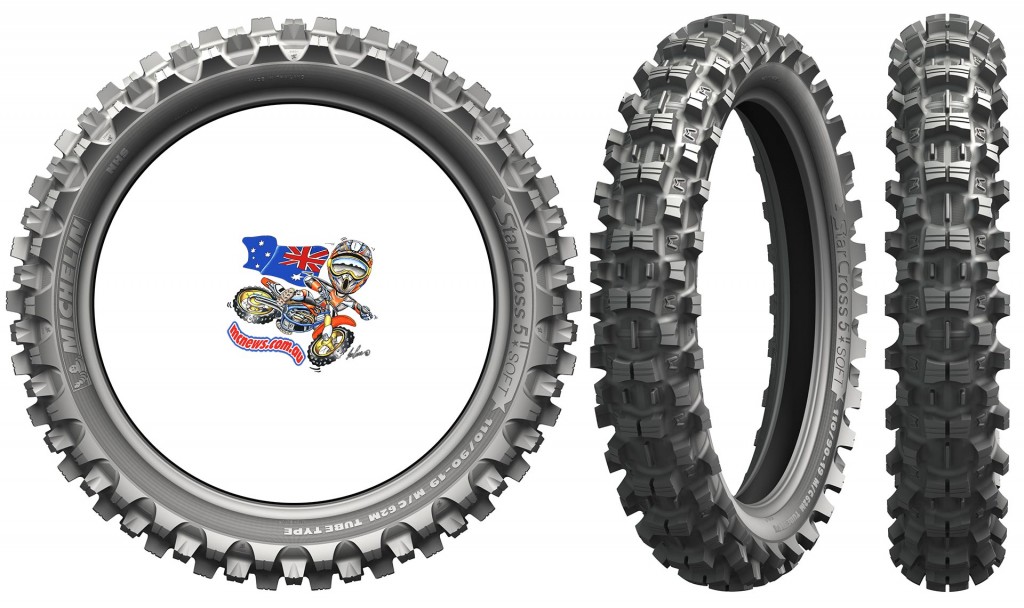 You’re done!
You’re done!
Oli Woodman / Immediate Media
If your bicycle has a Presta type valve such as this one then you will first have to remove the plastic valve cap (if fitted).
Oli Woodman / Immediate Media
The plastic cap will reveal another threaded cap to the valve.
Oli Woodman / Immediate Media
Unscrew the thread but be careful to not damage it in the process.
Oli Woodman / Immediate Media
Now attach the head of your chosen pump to the open valve and inflate the tyre to a pressure that’s between the minimum and maximum stated on the tyre’s sidewall.
Inflate the tyre to the desired pressure and remove the pump.
Oli Woodman / Immediate Media
Finally, close the valve by screwing it clockwise and reinstall the plastic valve cap.
If you have a tubeless setup, or tubes setup with sealant inside, then it’s worth taking a few extra steps to avoid gunking up your pump.
Turn the wheels so the valves are at the bottom and leave for a few minutes so any sealant can drain out.
Turn the wheels so the valves are at the top and pump up your tyres. The same goes when deflating tyres to prevent goop spraying everywhere.
We’d say that, if you can only own just one type of pump, get a track pump for home use because it’s efficient, quick and easy to use.
However, there’s no doubt that having an additional mini-pump for when you’re out on the road is rather useful – otherwise you risk being stranded at the roadside in the event of getting a puncture.
We’ve already got a guide on choosing the best bike pump for your needs, but here a few recommendations for you to consider.
The sky’s the limit with track pumps. They basically all do the same job, some with a more premium feel than others.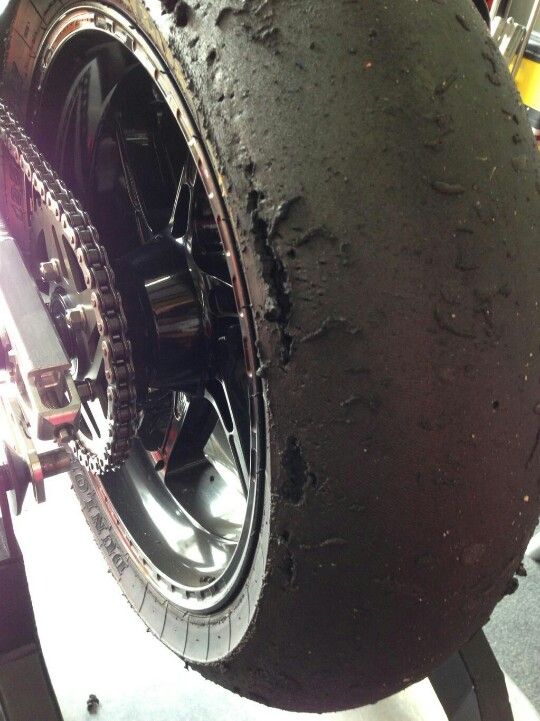
From a budget Park Tool PFP8 to the absurdly expensive Silca Pista Plus, you’ll be able to find something that suits your needs.
Mini pumps work but are a lot more frustrating to use. Again, there are lots of options available from mini track-style pumps to tiny pumps that will fit in a jersey pocket. We tend to prefer mini pumps with a hose because that reduces stress (and potential damage) on the valve.
Two of our favourites have been the Truflo TIO Road and the Lezyne Micro Floor Drive HP.
One other possibility for your inflation needs is a CO2 inflator. These use compressed carbon dioxide in a small cartridge to inflate or top up a tyre really quickly. Not something you would want to use on a regular basis, but perfect for an emergency repair.
The first thing to do is to attach your pump to the valve.
Remove the valve cap, and regardless of valve type, we find it’s good to release just a little hiss of air to ensure the valve isn’t stuck and opens and closes cleanly. Either thread-on the chuck or push it on and lock it.
Either thread-on the chuck or push it on and lock it.
If your tyre is completely flat it may initially be a bit of a struggle to fit the chuck because the valve has a tendency to push back into the rim. Simply hold the valve from behind by pushing on the outside of the tyre so that you can lock the chuck on properly.
The lockring on Presta valves (if fitted) can also help, preventing the valve from disappearing by holding it in place for you.
The connection to the valve should be air-tight. A little escaping air is normal when attaching the pump, but shouldn’t continue for long. If it does, remove and reattach the chuck. If it continues to be a problem it may be worth checking the rubber seal in the chuck to see if it is worn out and needs replacing.
Remember to be gentle with the valves – they’re delicate. That’s especially the case if you’re using a mini pump without a hose.
Make sure to brace the pump with your hand wrapped around the spokes or tyre to avoid transferring too much of the pumping force to the valve, which could lead to damage.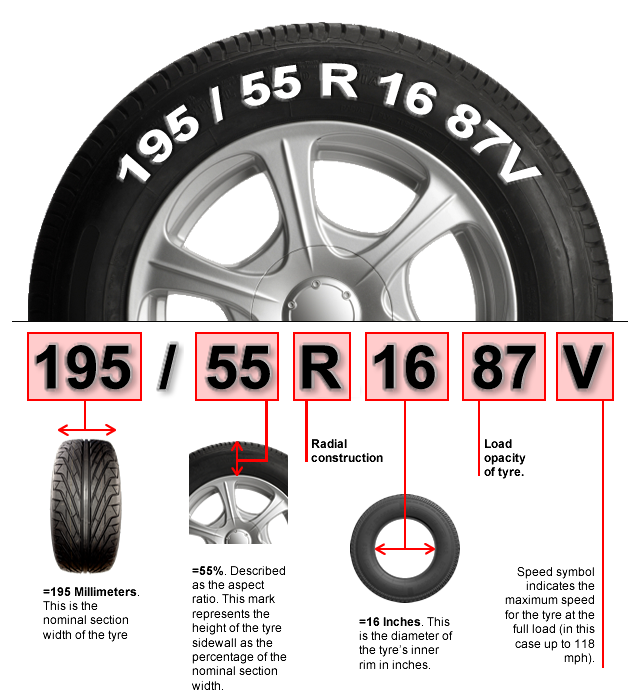
When you start pumping make sure to use the full stroke of the pump. You’ll find that the majority of the stroke is taken up compressing the air to the point where it will then be pushed into the tyre.
If you don’t use the whole length of the pump, the air won’t be pushed out of the bottom – you need to generate overpressure in order to move the air from the pump to the tyre. Instead, you’ll just end up with the shaft bobbing around doing nothing.
With a track pump, don’t just use your arms, use your body weight for the downstroke and pumping will become a lot easier.
You may sometimes find that the pump doesn’t seem to hold pressure, especially when inflating the tyre from completely flat. This may especially be the case with an older pump where seals may be slightly sticky.
We find it helps to pump vigorously initially, to generate enough back-pressure (i.e. pushing back from the tyre side) in the system to ensure that valves are actuated properly and seal up, in turn inflating the tyre. Keep on going until you get the right pressure.
Keep on going until you get the right pressure.
When removing the chuck from the valve there is usually an audible hiss of air being lost. This is usually from the pump rather than the valve side. Pressured air in the hose and chuck is just escaping.
A pump gets the air in your tyre. The operating principle is simple; you increase the pressure inside the pump until it exceeds that inside the tyre. This ‘overpressure’ forces air into the tyre, increasing its pressure too.
A pump is just a manually actuated piston. On a pump’s downstroke, a check valve (allows air-flow in one direction) seals the piston chamber, resulting in air being pressurised as the pump is compressed. That pressure increases until it exceeds that inside the tyre.
At this point, a second one-way valve will allow air to flow from the pressurised pump chamber into the tyre. You extend the pump again, the check valve opens to refill the chamber with air and you repeat the process.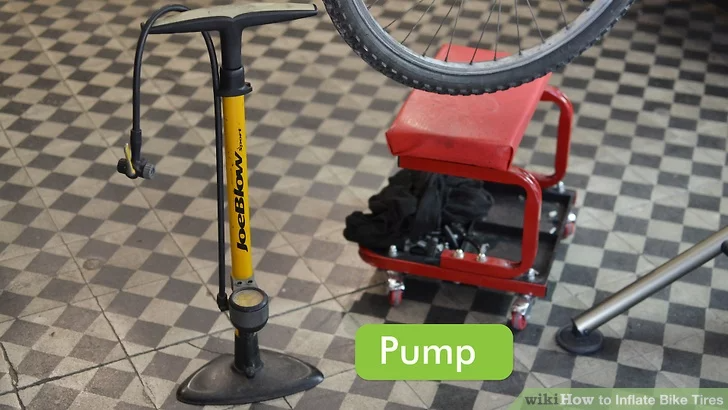
To prevent the pressure in the tyre leaking back out, the second check valve at the base of the pump closes. If it wasn’t there, the pump would just shoot open again.
Presta valves will close automatically, but the sprung Schrader valves are usually held open by a pin in the pump valve attachment (this means you don’t need any extra effort when pumping to overcome the pressure exerted by the spring.)
The head of the pump is also known as the chuck.Oliver Woodman / Immediate Media
The chuck is the part that attaches the pump to the valve and forms an airtight seal over the valve. One of two designs exist: threaded or push-on with a locking lever. Most pumps nowadays are also adaptable to either Schrader or Presta valves.
They will either feature two different attachment points or an adjustable chuck that can be changed to suit both types.
For larger pumps (and many mini-pumps too) the chuck is often on a hose, preventing your pumping force from damaging the valve.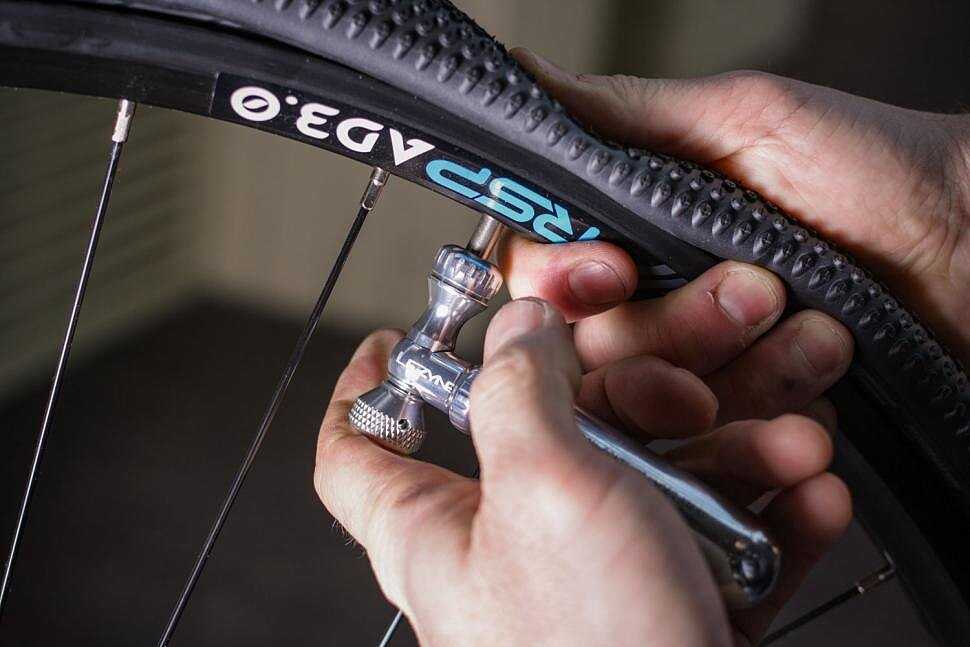
Pumps will often include a pressure gauge to check the pressure inside your tyre.
The right tyre pressure is perhaps one of the most contentious subjects, but there are definitely a few guidelines that you can use.
As a general rule, your tyre should be solid enough to prevent the tyre deflecting all the way to the rim, though compliant enough to provide some suspension – after all, the beauty of a pneumatic tyre is that you don’t have to have a bone-jarringly hard ride.
Most tyres will have a minimum and maximum pressure rating printed on the side. It’s advisable not to go under or over those limits because manufacturers have specified them for a reason. Of course, that means there’s still a lot of room to play with pressure and what works for you.
For mountain bikes the problem is relatively easier, with the usual aim being to improve traction, cornering and shock absorption.
As a general rule, riders try to run as low a pressure as possible without having it so soft that the tyre squirms under cornering load or deflects enough for damage to occur to the rim.
For road bikes it becomes a little more complicated because along with traction and comfort, rolling resistance (how efficiently a tyre rolls) is a major consideration as well.
Contrary to what many assume, the new school of thought seems to suggest that harder is not necessarily faster.
On all but the smoothest of surfaces, a hard tyre will not have as much suspension, and instead of the tyre being able to deflect and conform to irregularities – keeping the bike moving forward – you will get bounced around.
On all but the flattest of surfaces softer tyre pressures can provide more comfort and be more efficient.
A tyre pressure drop chart.Frank Berto (Bicycle Quarterly)
The most comprehensive research into this was underatken by Frank Berto, who put together a tyre pressure inflation chart.
This testing determined that a 20 per cent tyre drop (the amount the tyre compresses when load is applied, measured by the height from the ground to the rim) was the optimum balance.
Incidentally, some manufacturers recommend a similar level of tyre drop, though the figure is open to some debate.
This value does provide a good starting point to experiment with tyre pressures. The chart looks at individual wheel load – i.e. your and your bike’s weight on each wheel (40 per cent front / 60 per cent rear is a good starting point) – and calculates the pressure for each accordingly.
You need not always get your pump/gauge out to check for tyre pressure.BikeRadar / Immediate Media
It’s a good idea to check your tyres before each ride. Usually, that just involves giving them a squeeze by hand to check the pressure.
No, it’s not super accurate, but you’ll quickly get a feel for the pressure in your tyres and be able to tell whether they need pumping up or not.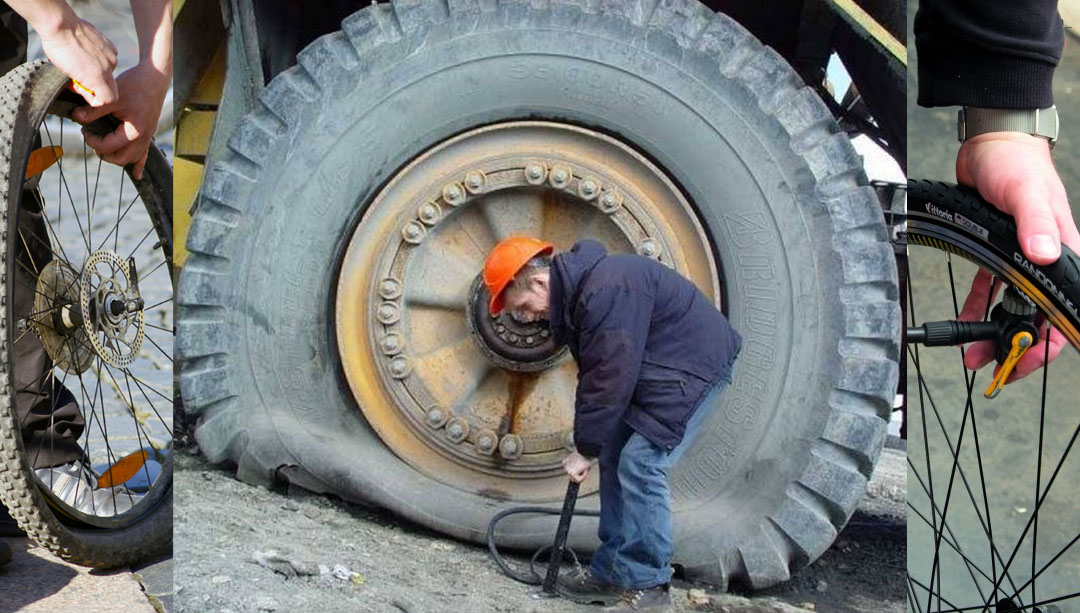
If you start to get really nerdy about it, you may end up investing in a pressure gauge, which can read the pressures in your tyres very accurately.
That’s especially helpful for mountain bikes where a few psi can make a large difference to handling and grip, but equally applicable on a road bike to find the exact pressure that works for you.
BikeRadar provides the world's best riding advice. We're here to help you get the most out of your time on the bike, whether you're a road rider, mountain biker, gravel rider, cycle commuter or anything in between. You can expect the latest news and features, in-depth reviews from our expert team of testers, impartial buying advice, how-to tips and plenty more.
by Mike Anderson
themikeanderson
6th July 2015While the majority of you will almost certainly know how to inflate the tyres on your bike, it’s another of those simple tasks, like changing an inner tube or using clipless pedals, that can seem pretty confusing to a beginner.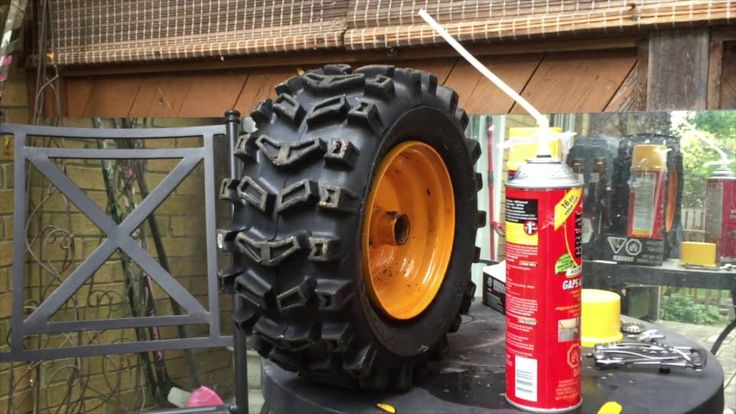
There are plenty of different types of pumps, inflators, valves, tubes and tyres – and all that can be a real nightmare if you’re coming to it for the first time.
If you ride a road bike, the Presta valve (above) is pretty much the only type of valve you’ll need to worry about dealing withSo here’s a handy guide to all things tyre inflation that’ll help to clear up any ambiguity surrounding the subject and have you fully inflated and ready to ride in no time…
The best place to start is what type of valves your inner tube (or tyres, if you’re running tubulars) have. There are two basic types of valves that you’ll find on bikes: Presta and Schrader. For the most part, inner tubes and tubulars on road bikes will use Presta valves, and mountain bikes will use Schrader valves.
The visual differences between the two are obvious, with the Presta (pictured above) being slimmer, lighter and having a lock nut to close that you can see on the top. Schrader valves are wider, more robust and have a spring mechanism on the inside to keep the valve closed, rather than a screwable top section.
Schrader valves are wider, more robust and have a spring mechanism on the inside to keep the valve closed, rather than a screwable top section.
Because the widths (or diameters if you prefer, seeing as they’re both cylindrical) are different, they’re not easily interchangeable in wheels that are designed to accept one type.
Schrader valves are too thick to fit through the tube hole in a road rim, and Presta valves will need adapters or shims (or an awful lot of electrical tape) to fit on an MTB rim. Plus, in really narrow road tyres, there might not even be space for the large Schrader valve to fit between the beads.
As they have no spring in the valve, Presta valves are easier to pump up than Schrader, especially so with small capacity hand pumps, and it also means small pumps don’t need an in-built device to depress the spring in a Schrader valve.
One of the smart parts of Presta valve design is that even when the top section is open, it won’t leak air unless it’s pressed down. That means even if you forget to rescrew after you’ve pumped the tyre up, you shouldn’t find yourself with a flat again 500 metres down the road.
That means even if you forget to rescrew after you’ve pumped the tyre up, you shouldn’t find yourself with a flat again 500 metres down the road.
Because the two valve types are different, they require two different types of head on a pump – or, as is often the case, an interchangeable head.
In other words, you can’t use a Schrader-headed pump to inflate a Presta valve tube without an adapter, and the opposite operation won’t work at all.
Fortunately, most modern floor pumps have a very simple answer for this: a pump head with dual attachments. And that’s even better if you ride both road and mountain bikes, because it means you only need the one pump for both jobs.
The Birzman pump (left) is set up for Presta valves in the picture, but to inflate a Schrader valve you have to unscrew and remove the gold section. But on the PRO pump (right) it’s much easier as there’s a dual head with an ‘s’ at on one side and ‘p’ on the otherSome are very obvious (like the PRO pump on the right of the picture) as there are literally two different attachments on the end of the hose but others (like the Birzman pump pictured left) require you to unscrew the end to reveal the Schrader adapter, or in some cases even flip the valve end over.
It’s still a simple operation but one that can seem completely confusing if you’re just standing there with the valve hose in your hands trying to figure it out.
When it comes to actually pumping up your tyres, there are a few different types of pump/ways to do it. The first and most common of these is the track pump. Track pumps are one of those essentials that every cyclist should own.
They’re usually around two feet high, have a fairly large capacity and are capable of inflating tyres to high pressures – usually much higher than required. For example, my track pump can inflate to 160psi which is far higher than I’d ever want my tyres.
Track pumps are quite large and generally kept in the garage (or wherever you keep your bike in the house) to pump up tyres before you ride.
The main bonus is that because of their high capacity, they make inflating tyres to high pressure comparatively easy – you can inflate a tyre all the way up to 100psi in 10-15 strokes easily (depending on pump capacity).
Then there’s the mini pump. Mini pumps are ideal to stick in your jersey pocket in case of a mid-ride puncture. Most are capable of inflating tyres to a reasonably high pressure (though not as high as a track pump), but it’s a longer and occasionally more frustrating experience.
However, no matter how frustrating it’s vastly preferable to being stuck 40 miles from home with a flat and no way of pumping it up.
Mini pumps come in various varieties – some more ‘mini’ than others – and most will have a tube that extends and packs back into the end of the pump in order to add a bit of flexibility without which it would be very easy to snap off the end of a Presta valve. You may laugh, but it can happen.
Mini pumps are ideal for mid-ride puctures. Most have a rubber tube that you can pull out of the pump to add some flexibility and make it easier to inflate tyres on the goThe third common option isn’t strictly a pump, it’s a mini inflator. These use a small valve ending and inflate using disposable CO2 canisters.
These use a small valve ending and inflate using disposable CO2 canisters.
The bonus of these is that they inflate incredibly quickly and, depending on the capacity of the canister, can pump a tyre all the way up to around 200psi – not that you’d need to go that high.
The down side is that each canister is single use only, so it’s only as good for as many as you’re prepared to take with you. The SKS Airboy CO2 combines a mini pump and CO2 inflator in one handy unit, which solves that problem.
Mini inflators are a great option for mid-ride punctures. They’re made of two parts – the gas cylinder (on the left) and the head unit (right). But each cylinder is single use only, so you’ll need to carry multiple if you want to be able to inflate more than one tube or tyreThere is one final option, and that’s an air compressor. However, they’re pretty expensive and almost exclusively used by pro team mechanics.
They do make the process an awful lot simpler, and they can also make it easier to hit a desired psi if you have a strong preference.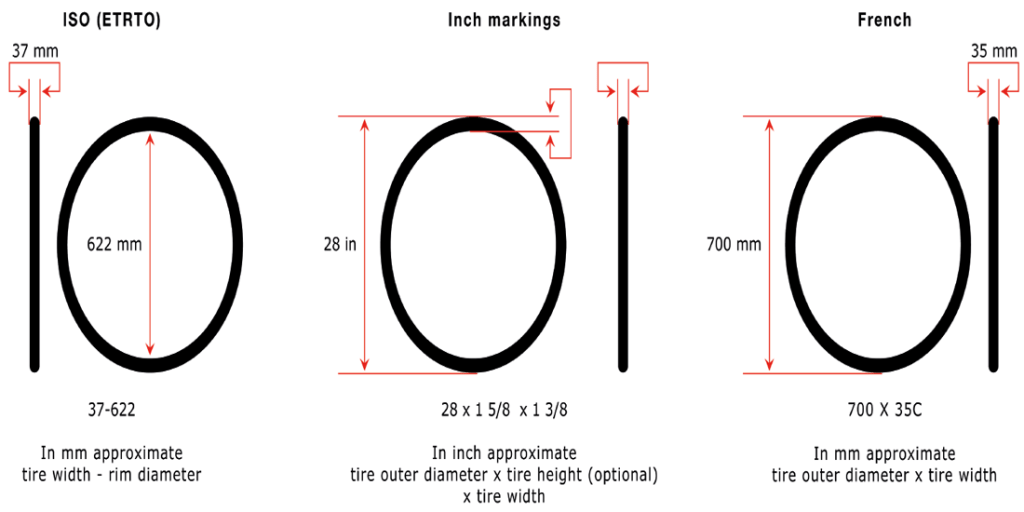 It also saves the pro mechanics from having to pump up 18 individual tyres on the bikes and all the spares every morning at a big race like the Tour de France.
It also saves the pro mechanics from having to pump up 18 individual tyres on the bikes and all the spares every morning at a big race like the Tour de France.
The first step is unscrewing the Presta valve head. It unscrews anti-clockwise and you’ll be able to see it moving upwards along the small central spindle. Make sure it’s open all the way.
Next, attach the pump end to the valve head. As I mentioned earlier, make sure you’re using the Presta attachment on the pump, not the Schrader as otherwise you’ll get precisely nowhere.
Also, you need to ensure the pump head is securely fastened onto the valve otherwise the air won’t go into the tube properly. It needs to be a sealed system to be most effective. How you create that seal depends on the pump. A lot will have a lever you flick up to secure the pump head, some will have a chuck to screw on.
Keep an eye on your track pump’s pressure gauge while you inflate your tyres. If you go over the recommended maximum pressure the results can be drastic, explosive and expensiveAfter that simply pump up the tyre, keeping an eye on the pump’s pressure gauge, and make sure you don’t over-inflate the tyre (most tyres will have written on the side the suggested pressure range).
While you might fancy going a little under the bottom number to cushion the ride or add a little more grip, going over the top one could cause the tyre to explode off the rim, potentially writing off the tyre, tube and rim.
Generally you can find a happy medium between the two through experimentation, and depending on your weight, where you ride, and how much cushioning you want the tyre to provide.
And that’s that. Now you’re ready to roll. Simple, right?
Please enter your email so we can keep you updated with news, features and the latest offers. If you are not interested you can unsubscribe at any time. We will never sell your data and you'll only get messages from us and our partners whose products and services we think you'll enjoy.
Read our full Privacy Policy as well as Terms & Conditions.
Cookies help us deliver our services. By using this website, you agree to our use of cookies. Learn More
Accept
production
It's no secret that the tire pressure of your bike, whether it's a road bike, mountain bike or hybrid, plays a major role in terms of your comfort and safety.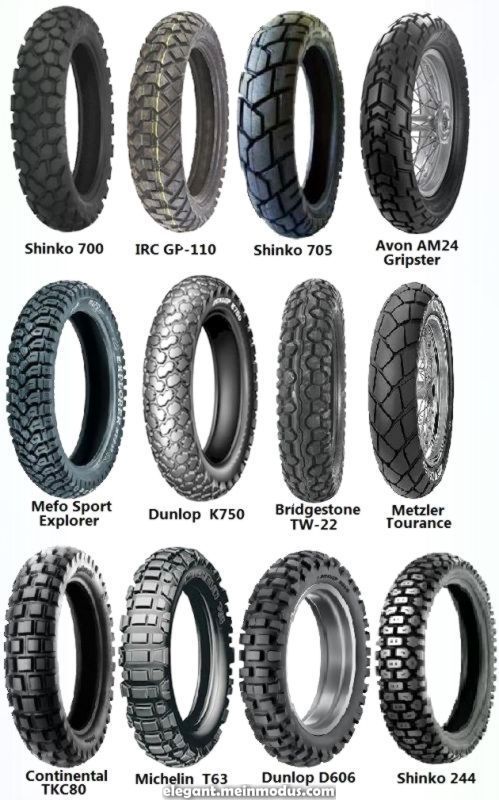 In this guide, we'll show you how to choose the best pressure for your riding style and conditions.
In this guide, we'll show you how to choose the best pressure for your riding style and conditions.
Correctly set tire pressure is a very important point that cannot be overestimated.
Tire pressure greatly influences tire behavior. Depends on it:
The larger the contact area of the tire with the surface on which it rolls, the better the grip - that's obvious. And this means that an over-inflated tire that touches the ground with only the center of the tread and bounces over all obstacles will have pretty poor grip.
Rolling resistance is determined by the friction between tire and surface; the greater this friction, the greater, respectively, the resistance. Thus, the area of contact of an underinflated tire with the surface is clearly too large, and therefore the rolling resistance in this case will be large.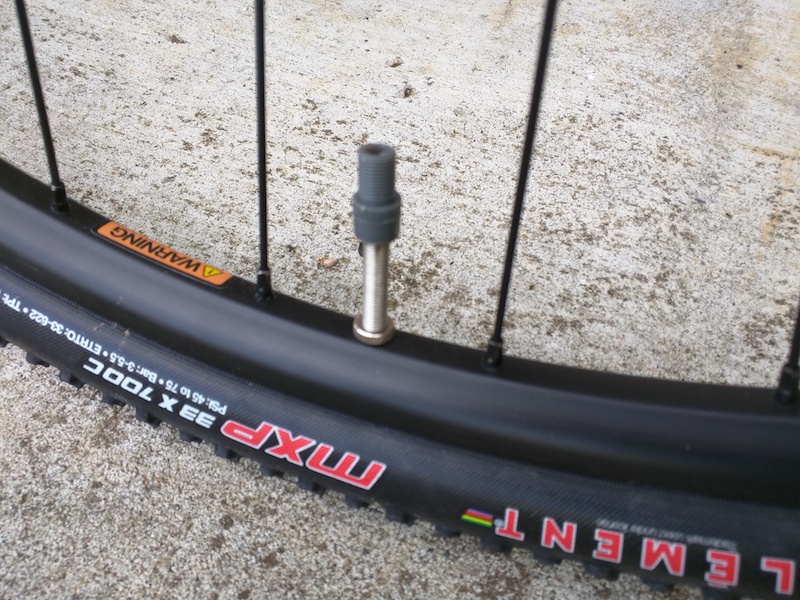 But, oddly enough, an over-inflated tire will also have a lot of rolling resistance, since it bounces over all the bumps and constantly breaks off the surface.
But, oddly enough, an over-inflated tire will also have a lot of rolling resistance, since it bounces over all the bumps and constantly breaks off the surface.
Therefore, in order to achieve a balance between optimal grip and good rolling, it is important to determine the tire pressure you need.
Before we talk about tire pressure any further, you need to know if your bike has tube or tubeless tires.
The "snake bite" thing can happen to tubes, especially if you ride with low tire pressure. The essence of this phenomenon is that with a sufficiently strong impact on an obstacle, the chamber is clamped by the tire cord and breaks through. This does not happen with tubeless tires, since there are no chambers in them, and therefore there is nothing to punch through.
Because of this, chambered tires are sometimes over-inflated to avoid snake bites.
The optimum tire pressure for your bike depends on what bike it is, what tires it has, and factors such as your weight, terrain, surface quality, and weather conditions.
Mountain bike tires are usually inflated less than road bike tires to help the tire roll better over bumps and for better traction.
The increased volume of these tires means that, despite the lower pressure, there is less chance of snake bites than with tubed road tires.
Below is the optimal mountain bike tire pressure for riders weighing around 70kg.
Tube tires:
Tubeless:
If rider weighs over 70kg, add 1psi for every additional 5kg of body weight.
Road bike tires are more inflated than mountain bike tires. This is done to further improve rolling and, in the case of tubed tires, to reduce the chance of snake bites.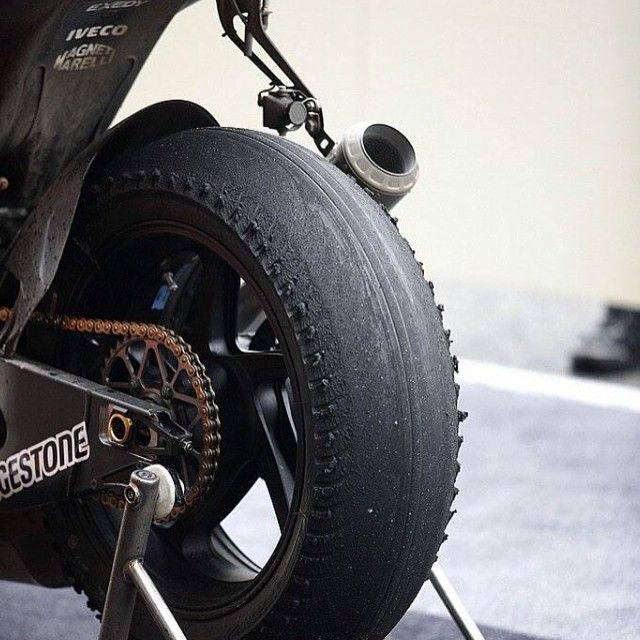
Below is the optimal pressure for road bike tires (25mm wide) for riders weighing about 70kg:
Tubeless:
If rider weighs over 70kg, add 2psi for every additional 5kg of body weight. If the rider is lighter than 70kg, remove 2psi for every -5kg.
Cyclocross/gravel tires pump more than mountain bike tires but less than narrow road clinchers. Everything to achieve the best balance between rolling and grip.
Below is a small guide to tire pressure selection for cyclocross riders. The table is suitable for tires with a width of 35mm and riders weighing about 70kg.
Tube tires:
Tubeless:
 5 atmospheres)
5 atmospheres) If rider weighs over 70kg, add 1psi for every additional 5kg of body weight.
The volume of hybrid tires is about the same as that of cyclocross tires, so the optimal pressure here will be about the same.
So, in the case of hybrid and city bike tires with a width of 35mm, the optimal pressure with tires for a rider weighing about 70kg will be as follows:
Tubeless: If the rider weighs over 70kg, add 1psi for every additional 5kg of body weight. In the case of a bike machine, there is usually no need to lower the pressure in the tires - there are no pluses in this. In general, the standard pressure in this case is 100psi. In case the tire constantly spins or slips, the pressure can be reduced by 10psi. As we know, many riders advise reducing tire pressure when riding on wet surfaces. In reality, this does not give much if the initial pressure was optimal for dry conditions. And in the end, most riders (including professional racers) will never stop and lower their tires when it rains. If you do decide to settle for a lower pressure than we recommend, at least don't decrease it by more than 2psi. If you deflate the tire too much, it can buckle and tuck, thereby depriving you of stability. All the pressures given above are pretty accurate, and some might say that their pumps (especially hand pumps) will never be that accurate. However, we should not forget what times we now live in. The pressure gauges of any pumps have already become quite accurate, and a modern pump allows you to inflate tires strictly in accordance with our instructions. Probably everyone who rides a bicycle has pierced a tire at least once. This is an unpleasant, troublesome and even a little insulting business. The most interesting thing begins when the puncture occurs far from civilization, and you did not take anything with you except water. Progress, however, does not stand still and offers us many solutions to this problem, which in August, by the way, in some regions, becomes a natural disaster. It's all because of the season of flowering "thorns". However, you can pierce in any other way. There are far more of them than there are ways to deal with them. In general, there is a problem - there are solutions. We will share with you 11 ways to deal with bicycle tire punctures. The method indicated under number 1 works flawlessly. It works at any time of the year and deprives the cyclist of a huge amount of hassle associated with patching the tubes. Deprives the method and the title of a cyclist. So, if this method does not suit you, then move on to point 2. Sealants vary in price, quality and composition. For road tires, he is one so that he can work at high pressures. For MTB tires, it is completely different, there are fewer requirements for it. There are sealants for chambers, and there are also sealants for tubeless tires. They differ from each other in composition and permeability. When a wheel is punctured, the sealant will flow through the puncture, dragging the filler with it. He, in turn, covers the hole, making its area smaller. If you haven't switched to anti-puncture tires yet, it's a good idea. They give a feeling of calm on the road for years. Anti-puncture rubber does not differ from ordinary rubber in composition. She is exactly the same. Although it is worth noting that puncture resistance responds to the extra weight of the tire, this cannot be avoided. The fact is that an additional layer of puncture-resistant material is built into the treadmill. This is not to say that it is impossible to break through it. Everything is possible. However, the penetration of the wheels drops sharply after installing such tires. Protection, of course, is different and depends on the discipline in which the tire is used. There are many weight and thickness requirements for racing road wheels, puncture resistance is good, but inferior to cruise tires. The latter weigh 5-7 times more than the road ones, also due to good puncture protection. Motorcycles and automobiles have long made the transition to tubeless tires. Bicycles also pass on them. So far, not very fast, although positive dynamics is developing from year to year. The advantage of tubeless tires is that there is no tube that gets punctured. Personal experience tells me that if you want, you can use even a regular tire tubeless, only very carefully and patiently. Cars and motorcycles run without sealant. If a puncture occurs there, then to eliminate it, there are special kits made of a “worm” of raw rubber and an awl, with which the “worm” is inserted into the hole. I think it would work on a bike too. Do not rush to condemn us for this way of dealing with punctures. We are talking about replacing the camera from butyl rubber with latex. The latter is very elastic and less prone to punctures. This means that when in contact with a sharp object, the camera tries to “hug” it without piercing. Such a camera will not provide full protection against punctures, but it will simplify life. On the other hand, latex cameras are also famous for the need to constantly pump up. That is, a butyl chamber needs to be pumped up, for example, once every two or three weeks, and a latex one every two or three days. These are tires that do not have a void inside. I remember such tires from childhood, they were on a tricycle. Yes, in general, they are used in many places. Contrary to popular belief, low pressure tires are more prone to punctures. Worn tires puncture more often. The fact is that the thickness of the rubber becomes smaller, it becomes easier for sharp objects to reach the inside of the wheel. Try to keep your eyes on the road. More precisely, if, then for its purity. The presence of glass and other artifacts should send you on a different trajectory. Water acts as a lubricant for objects that aim to penetrate your tire. I don't know what else to add here. Is that information about the article, where we talk about actions in case you get caught in the rain. You'll have to go to a bike shop and buy yourself a set for patching tubes on the road. Modern sets are the size of a matchbox, so there is room for it. The situation is worse with pumps. They are bulky. No, well, there are, of course, very small ones ... I have one of these. I tried to pump a road wheel with it. Once. Do not want anymore. It does not give pressure and it takes an incredibly long time to pump, but it is only 10-15 cm long and has a built-in hose, which is very convenient on the road. Full name Borik Vladimir Passionate cyclist since 2014. He could not stand it when the bike made extraneous sounds in motion, which made him go over everything, re-grease and renew it many times.
Optimum tire pressure for a bike machine  It may be advisable to reduce the pressure only in rare cases, and even then this decrease can affect the readings of the computer on the machine.
It may be advisable to reduce the pressure only in rare cases, and even then this decrease can affect the readings of the computer on the machine.
Changing tire pressure for wet conditions
Get the pressure right 
11 ways to deal with bicycle tire punctures

1. Do not ride a bike
2. Fill in sealant
Sealants are water based and contain filler. In some compositions, it is made as a small rubber crumb, in some compositions it is a small pile. 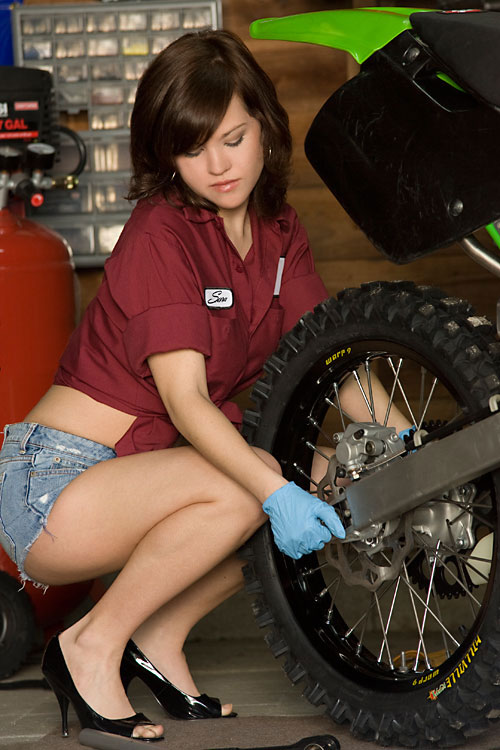 Then the composition of the liquid begins to act, it thickens and turns into a kind of rubber. The wheel in this scenario will lose some amount of pressure, but in practice it often turns out that it does not have time to go down too noticeably and the rider only knows about the puncture in the parking lot when he sees a wet spot on the rubber.
Then the composition of the liquid begins to act, it thickens and turns into a kind of rubber. The wheel in this scenario will lose some amount of pressure, but in practice it often turns out that it does not have time to go down too noticeably and the rider only knows about the puncture in the parking lot when he sees a wet spot on the rubber.
In practice, if after a couple of years of operation, drain the sealant and pump up the wheel, it turns out that it looks like a sieve. There will be a lot of holes. You should not worry while you are driving, none of them will make itself felt. Even a simple bicycle will not affect the manifestation of punctures. But the release of all the air and re-inflating the next day will show everything. Although even here it is enough to turn the wheel so that the sealant spreads and stops all leaks.
3. Anti-puncture tires 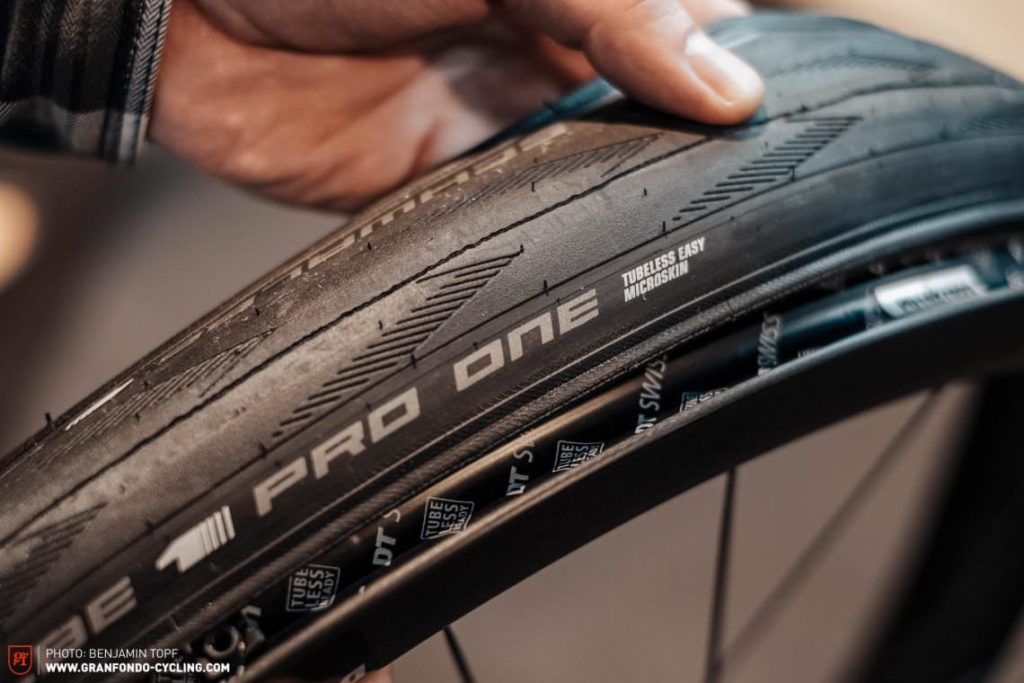 Yes, years without punctures and without restriction in movement. It happens, I assure you.
Yes, years without punctures and without restriction in movement. It happens, I assure you.
Schwalbe Marathon Plus is a versatile tire with very good puncture protection. Available in almost all possible sizes. Where to buy: Ukraine, Russia, Great Britain  Protection is located not only on the treadmill, but it is also on the sidewalls, although not all models have it.
Protection is located not only on the treadmill, but it is also on the sidewalls, although not all models have it.
4. Tubeless tires
No, of course, the tire itself still breaks through and threatens to reduce the pressure to zero. That is why sealant is poured into bicycle wheels. That is, if a puncture occurs, it immediately clogs the hole. Not any, yes, but it clogs! The technology of tubeless tires and rims for bicycles is becoming more accessible every day. There are on sale both rims without holes for the spokes on the inside, and kits that allow you to make a tubeless rim from a regular rim. True, the rim walls must still be prepared for tubeless mode.  She will need to be given some time to seal the pores over the entire area.
She will need to be given some time to seal the pores over the entire area.
5. Replacing the chamber
Latex tubes are available for all wheel sizes. Buy 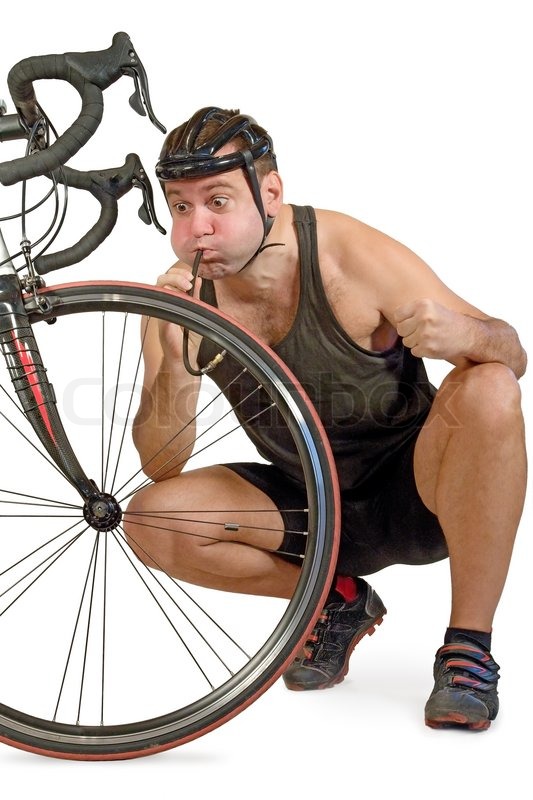 Such is their feature. Another option concerns conventional butyl chambers with sealant inside. Such a chamber can be purchased ready-made, or you can download sealant into a regular chamber. It doesn't change the essence.
Such is their feature. Another option concerns conventional butyl chambers with sealant inside. Such a chamber can be purchased ready-made, or you can download sealant into a regular chamber. It doesn't change the essence.
If you don't want to fill in the sealant yourself, Slime chambers will help. Where to buy: Ukraine, Russia, UK
6. Solid or hard tires
Tannus is a bright and almost the only representative of such tires for bicycles. Their product allows you to completely forget about the pump and just enjoy the ride. Of course, you have to pay for such a solution with difficulties in wheel beading and rigid wheels, the pressure of which cannot be adjusted to the conditions of the road surface.
7. Pump up the tires  Well-inflated wheels, on the other hand, are highly resistant to punctures. The biggest danger in flat tires is the possibility of a snakebite puncture. It happens when you hit a curb, for example. The tire is crushed, and the chamber inside is clamped between it and the rim. It turns out two points of contact with the rim, and hence two punctures, which are almost impossible to seal in practice. That is, you will put the patches, but the pressure of the camera will still start tearing further or simply undermine the patches.
Well-inflated wheels, on the other hand, are highly resistant to punctures. The biggest danger in flat tires is the possibility of a snakebite puncture. It happens when you hit a curb, for example. The tire is crushed, and the chamber inside is clamped between it and the rim. It turns out two points of contact with the rim, and hence two punctures, which are almost impossible to seal in practice. That is, you will put the patches, but the pressure of the camera will still start tearing further or simply undermine the patches.
In order to inflate the wheels correctly, you must have a pressure gauge and carefully read the information on the sidewall of the tire. The minimum and maximum tire pressures are always listed there.
By the way, we wrote a separate article about the air pressure in bicycle tires, we recommend that you read it.
8. Check the tire for wear 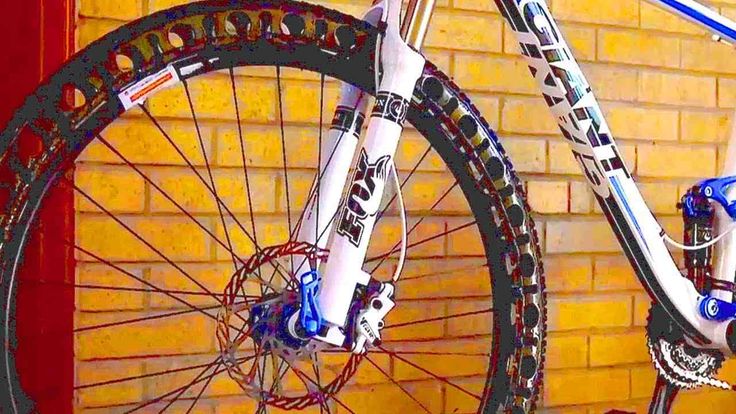 So... check your tires often, then you will be able to see in advance pieces of glass that are stuck or thorns that have not yet had time to completely break through the tire.
So... check your tires often, then you will be able to see in advance pieces of glass that are stuck or thorns that have not yet had time to completely break through the tire.
The most pronounced tire wear, in the context of punctures, is on MTBs. Everything is obvious here - the high tread simply did not allow the base to touch the ground. When the tread is worn down to 0, then the base is already affected by sharp objects.
Plus, you'll always know when to change your tire.
9. Watch the road
It is safest to drive on a car track, not on the side of the road. Again, we are talking about security in the context of punctures. From the point of view of traffic safety, it is more expedient to drive along the side of the road, where, by the way, there are more than enough sources of puncture.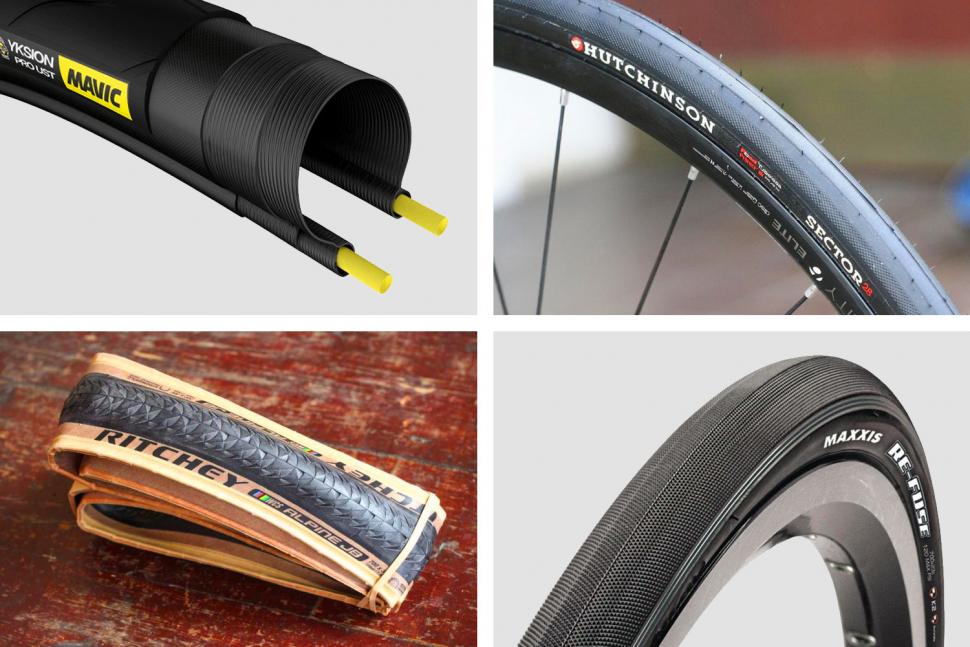
9. Avoid driving in wet weather
11. Prepare for a puncture
Tire removal tools, pump and tube repair kit with patches and glue 